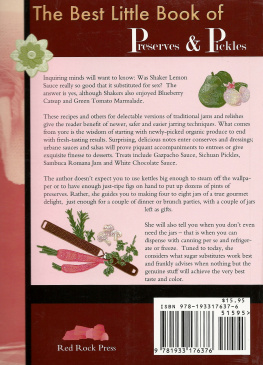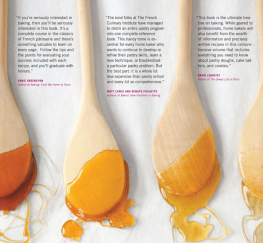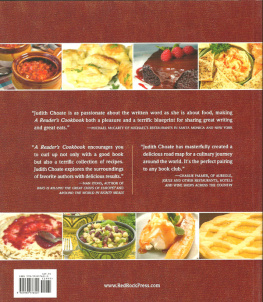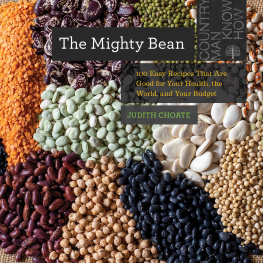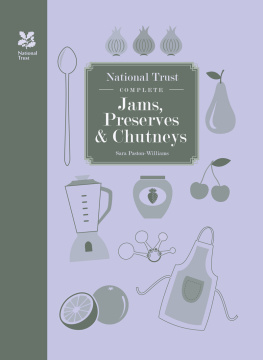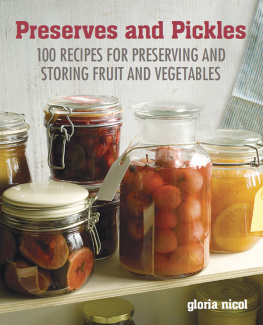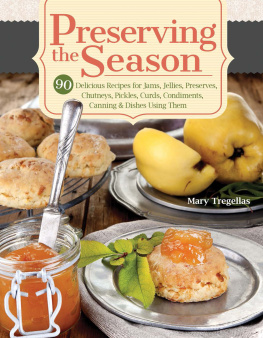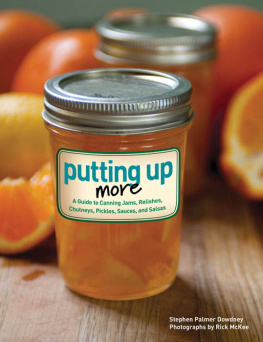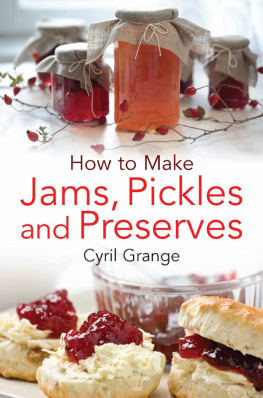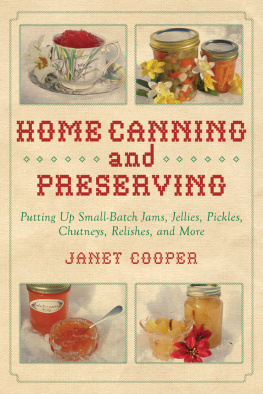

The Best Little Book of Preserves & Pickles
Copyright 2011 Judith Choate
978-1933176-543
Red Rock Press
New York, New York
www.RedRockPress.com
All rights reserved. No part of this book may be reproduced, stored in a retrieval system or transmitted in any form or by any means without the written consent of Red Rock Press. Inquiries should be directed to .
Design by Susan Smilanic, Studio 21 Design & Advertising
Index by Sayre Van Young
Choate, Judith.
The best little book of preserves & pickles : easy jams & jellies,
chutneys & condiments, sauces, spreads & syrup / by Judith Choate.
p. cm.
Includes index.
ISBN 978-1-933176-54-3
1. Condiments. 2. Pickled foods. I. Title.
TX819.A1C496 2011
641.462--dc22
2010048669
For Lynn, the best friend a girl could have
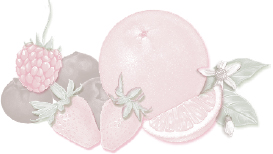

Table of Contents

INTRODUCTION

No matter how superb or unusual the commercial product, it will never equal the ultimate preserves made in your own kitchen.
This book is for the experienced cook who wants to produce small amounts of the very best preserves. Sweet or savory, spread, sauce or condiment, these are recipes to give your own menus that extra gusto and to provide the perfect on-hand gift for fellow food lovers. Although canning often carries with it no small measure of fear (even in the mind of the most accomplished cook!), it is really quite a simple kitchen task that, once tried, will often become a favorite pastime since the results are so rewarding.
The surge of interest in foods American, the proliferation of restaurants featuring American cuisine and the Americanization of international recipes have led us back to the discovery of our native cuisine.
Our regenerated preference for fruits and vegetables grown in our own gardens or nearby locavore, if you will and so requiring little time and fuel to reach our kitchen also inspires us to preserve seasonal bounty.
Our forefathers ate and preserved far more foods than most contemporary Americans will ever taste. Many foods that we now consider special were frequently on the average persons plate in the early 20th century: game, wild greens, free range chicken, unadulterated meats, native herbs and fruits. Items for which we will now pay extra were once just plain food. It is interesting to note that gourmet preserving is not new, just rediscovered.
The history of putting foods by has been greatly enhanced by American ingenuity. From the early colonists preservation of new and different native foodstuffs for times of scarcity to the invention of freeze-dried meals in the 20th century, Americans have constantly created inventive ways to store foods. However, it was the advent of the 19th-century Shaker communities that most profoundly affected American preserving.
The Shakers arrival in America, in 1774, marked a time of change and freedom, a time for new thought and creation. Then, when the Revolution freed the colonies from England, its newlyminted citizens strove to establish a truly American life. Having brought traditional preserving methods with them from the Old Country, Americans began to expand their preserving skills using regional American produce. Martha Washington, as First Lady, became an advocate of American cooking, and culinary invention flourished.
By the mid-1860s, the Shaker community had grown from seven members to several communities with thousands of members in many states. Each community not only was self-sufficient but grew and made enough to sell to the outside world. Shaker kitchens were models of efficiency and cleanliness and were the earliest example of mass production. The canning kitchens were equipped (and still are, in both museum and contemporary living settlements) with huge stoves, great copper canning kettles and pristine spaces in cupboards and on long trestle tables to facilitate the production of preserved foods. Filled with advanced conveniences and inventions, the Shaker canning kitchen created a demand in the general public for products carrying the Shaker label. The quality, integrity and care that characterized these products established, for the American housewife, a high standard to duplicate in her own kitchen.
In fact, in areas where Shaker communities flourished it was not at all unusual for an outside family to take its own produce to be preserved by the Shaker sisters. Their recipes used the best they could grow, were seasoned with imagination and were stored in the most beautifully crafted containers they could create. Not only did they cook, they did so with inventiveness, skill and with the knowledge that food was one of Gods rewards. This is the heritage that is the basis for the current interest in our native cuisine, of which preserving the best foodstuffs a cook has at hand is an integral part.
The wide availability of a variety of fresh fruits, vegetables and herbs has now made it possible to prepare canned goods all year long. However, it is always preferable to use local products during their individual growing seasons. And, of course, locally and organically grown products offer the cook the additional assurance of quality. Januarys picture-perfect, flavorless tomato, the stored apple of March and the year-round frozen strawberry all have a fraction of the taste, smell and texture of their garden-fresh counterparts. When feasible, I recommend that you do your preserving seasonally. When this is not possible, purchase the best available from a supermarket, greengrocer or local wholesaler. You can also experiment with the exotic produce now imported from around the world for American consumption. The end result will be well worth the extra time, effort and money you put into selecting quality ingredients for your gourmet preserves.
What are gourmet preserves? Unique combinations, careful flavoring, color and pure, clean taste are the most important components of what should be a welcome addition to any menu and should turn a mundane meal into an extraordinary dining experience. They should be produced from the finest quality ingredients, organically and locally grown if at all possible. No grape jelly or ordinary dill pickles here!
Sophisticated preserves have evolved from our American culinary heritage. They combine the best of the old with the convenience and availability of the new. It is the legacy of our forefathers (and mothers), the integrity and ingenuity of the Shakers and the cooks flare for experimentation and discriminating taste that combine to produce gourmet preserves. Every wonderful food that we know as American can be brought to the table from a bag, a carton, a jar, a can or a crock. Just let this book be your guide.

C HAPTER 1
THE RIGHT INGREDIENTS
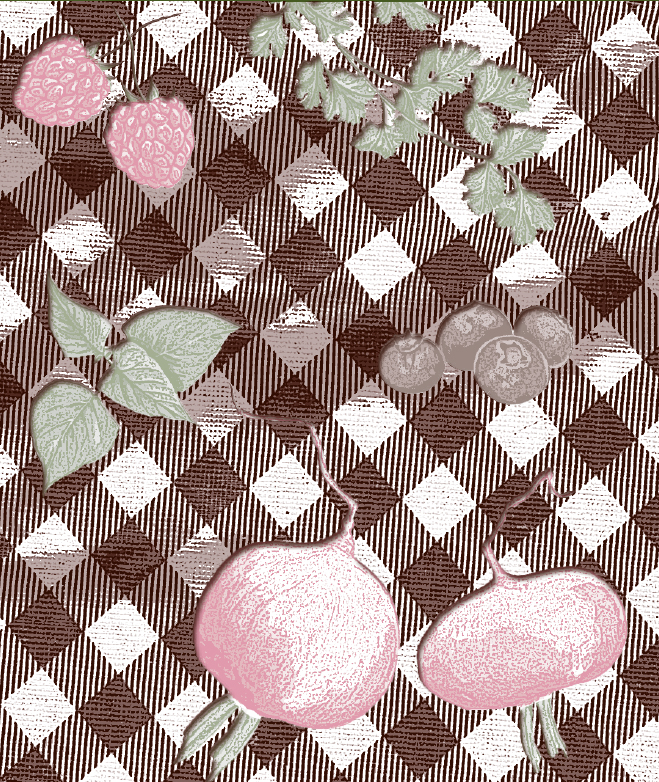
Next page
